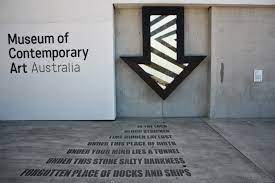
Paul Klee. Separation in the Evening. 1922.
“Every morning brings us news of the globe, and yet we are poor in noteworthy stories. This is because no event comes to us without being already shot through with explanation. In other words, by now almost nothing that happens benefits storytelling; almost everything benefits information. Actually, it is half the art of storytelling to keep a story free from explanation as one reproduces it. . . . The most extraordinary things, marvellous things, are related with the greatest accuracy, but the psychological connection of the event is not forced on the reader. It is left up to him to interpret things the way he understands them, and thus the narrative achieves an amplitude that information lacks.”
― Walter Benjamin, Illuminations: Essays and Reflections
Taking another look: the marvellous in debate and seeing again.
The title “Separation in the Evening” 1992 by Paul Kee attracted my attention. Recently I visited the MCA and considered the contemporary illuminated “arrow” by Brook Andrew, for me, looking up at the Emu Dreaming is looking down at the landscape, sacred ground hidden beneath the grass and concrete of the building – once the Maritime board (1939 commissioned for design / building) Sydney MCA. The architectural style, art-deco inspired, reminds me of Fritz Lang’s Metropolis revealing the above ground world and the shady, underground: the criminal hidden elements in Lang’s Metropolis and M become the architecture, the way we occupy spaces and are manipulated and manoeuvred through those spaces to “see” certain views and viewpoints. Klee’s Separation in the Evening is often used as a tint and tonal exploration for art students (young ones). The layers and separation through shade, tone and tint are, for me, architectural. Like sandstone blocks the lines and texture reveal a hidden depth: the separation (the title) hides or conceals that depth or that which needs to be close but doesn’t know how or is prevented through architecture and ways of seeing. Is there a matching arrow we can’t see that is hidden beneath the MCA? Or, like Klee’s evening, are the murky waters of the harbour trying to turn us around and see?
The arrows point down or up, like a reflection in a night water or harbour. What is reflected is Andrew’s illuminated arrow is also what is concealed or denying reflection: the emu, the sacred ground as well as the convict and colonial past now hidden in broken or fragmented Dreaming stories. Like Philosophy, some believe is a conversation looking back and questioning Plato and Socrates art too is a conversation between artists and ways of seeing – privileged and gifted for reframing in the present. I stumbled into this conversation thinking of Brook Andrew’s arrow and Paul Klee’s title. I now open this stumbling with some illumination from Water Benjamin’s writings, especially concerning interpretation and the “marvellous” feeling – not unproblematically (a philosopher might question my borrowing of this concept when it hints at the ultimate meaning of “reality”) – art can offer when no-one agrees and the conversation arouses discuss, debate and some warmth from the fire that glows with lighting the forgotten, or shaded artworks that are often walked past, overlooked or displayed as an entrance to discover something else.
© Cate Andrews, 2024.
You must be logged in to post a comment.